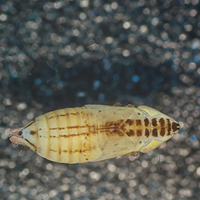Red-tailed Leafhopper
Scientific name: Aflexia rubranura

Photo credit: Rob Foster CC BY 4.0
Status
Special Concern
“Special Concern” means the species lives in the wild in Ontario, is not endangered or threatened, but may become threatened or endangered due to a combination of biological characteristics and identified threats.
Date added to the Species at Risk in Ontario List
January 26, 2022
Read the assessment report (PDF)
What it looks like
Red-tailed Leafhopper is a small, pale insect that is about 2 to 4 mm long with distinct dark dorsal markings on each side. Adult males have a red-tipped abdomen.
Where it lives
Red-tailed Leafhopper is found in open grassland and savanna habitats where its host plant, Prairie Dropseed (Sporobolus heterolepis), grows. The population of Red-tailed Leafhopper found in Ontario is part of the species’ Great Lakes Plains designated unit. This designated unit is found entirely in Ontario.
Where it’s been found in Ontario
Red-tailed Leafhopper is currently found on alvars and dolomite ridges on Manitoulin Island and a few smaller nearby islands. Its distribution aligns with the distribution of Prairie Dropseed, its only host plant. The species may also be found in suitable habitat at other unsurveyed areas where Prairie Dropseed grows.
What threatens it
The species’ range in Ontario is small and it has limited ability to move to new areas, making it extremely susceptible to disturbance from various threats. The greatest threat to the species in Ontario is currently aggregate extraction, which can adversely impact members of the species directly as well as through impacts to its host plant.
Fires present another threat to the species given eggs and nymphs occur above ground and adult members of the species are unable to fly so cannot escape a blaze. Other activities that may result in habitat loss and fragmentation also threaten the species, such as development and conversion of habitat for other uses, such as agriculture.
Action we are taking
Special Concern species do not receive species or habitat protection.
What you can do
Report a sighting
Submit your observations of species at risk to the Natural Heritage Information Centre (NHIC), which is Ontario’s conservation data centre. Join the “(NHIC) Rare Species of Ontario” project in iNaturalist to make submitting your observations quick and easy.
Volunteer
Volunteer with species at risk programs, such as community science surveys, through your local nature club, a provincial park or other conservation organizations.
Be a good steward
Individuals, communities and organizations across the province who undertake stewardship or research activities that benefit species at risk and their habitats may be eligible to receive funding through the Species at Risk Stewardship Program (SARSP). The SARSP was created to encourage people to get involved in protecting and recovering species at risk in Ontario through stewardship actions.
Report illegal activity
Report any illegal activity related to species at risk to
Quick facts
- Red-tailed Leafhopper only feeds on Prairie Dropseed (Sporolobus heterolepis).
- Red-tailed Leafhopper cannot fly, which can make it difficult for members of the species to escape threats such as wildfires.
- In Ontario, the species is thought to have one generation per year.